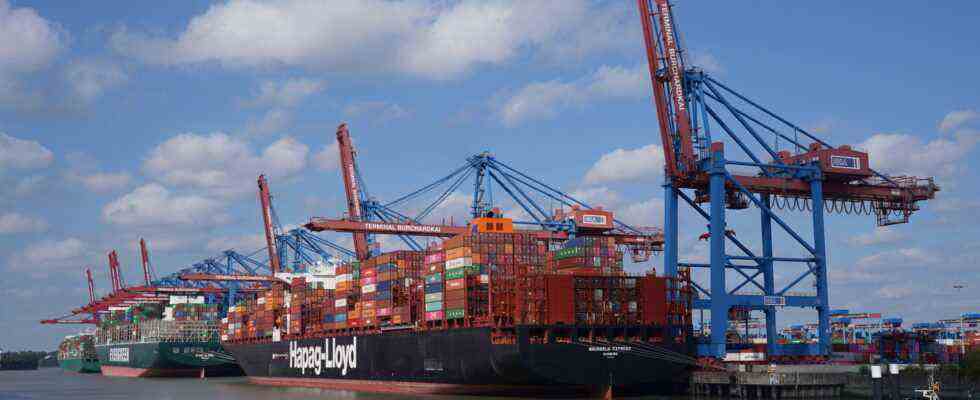Status: 02/09/2022 10:17 a.m
German exports grew by 14 percent in 2021 compared to the previous year – also because of the catch-up effects. Thanks to full order books, companies are confident about 2022. But many factors create uncertainty.
Exports in Germany increased strongly again last year. This was announced by the Federal Statistical Office. The increase of 14 percent to 1,375.5 billion euros has to do with the pandemic: In 2020, foreign trade also felt the effects of the corona-related restrictions. At that time, exports of goods collapsed by a total of 9.1 percent. Now the export-oriented companies are on course for recovery. The chemical industry, but also the electrical industry and mechanical engineers are looking to the new year with confidence.
Many worries and high costs due to Corona
Bernd Clemens walks through the production hall of his mechanical engineering company in Wittlich, Rhineland-Palatinate. Work is being done at every station. “We adjusted to the supply chain problems early on. That’s why we ordered a lot in advance, even if we didn’t know the price in some cases. Our warehouse is full. That’s why I’m confident for 2022,” says the company boss, while looking through the Factory hall moves.
His family business manufactures special equipment for viticulture and fruit growing. Exports go to the USA and Italy, among others. Thanks to the forward-looking purchasing policy, the company was able to produce at full capacity even during the crisis – in contrast to the vast majority of companies in Germany.
| buyer country | Exports 2021 | Change compared to 2020 |
|---|---|---|
| 1. United States | 122.1 billion euros | +18.0% |
| 2. China | 103.6 billion euros | +8.1% |
| 3. France | 102.3 billion euros | +12.6% |
In the past two years of the pandemic, there have always been concerns – about closed borders or the sharp rise in material costs. “We had to increase our prices by six percent last summer and now at the beginning of the year. But that doesn’t come close to covering the entire additional costs for the intermediate products,” calculates Clemens. The next price increase may come in the summer.
In addition to the costs for material, the expenses for transport also increase. Clemens explains that they are currently waiting for freight from Wittlich at the company’s branch in Sacramento, California. The containers for the transport are just as difficult to get as a place on the ship. “We hope that the goods will finally have all arrived in the USA in two months,” complains Clemens. In some cases, machine parts would even have to be delivered by plane. That drives up the costs enormously.
The order books are filling up again
Despite all the imponderables, the order book at Clemens is full and international demand is very high despite the many uncertainties caused by the pandemic. From Clemens’ point of view, the “Made in Germany” seal is particularly valuable right now. “The customers rely on the products and the great reliability from Germany. That is a great location advantage in these times.”
The industry association VDMA in Frankfurt is also optimistic. Here the experts have corrected the growth prospects for this year upwards from five to seven percent. The reason: due to the lack of material last year, orders were postponed to 2022 and would then be processed in the coming months. Here, too, people are looking forward to the new year with confidence: the VDMA estimates that the problems with missing material should become smaller from the second half of the year.
Electronics industry confident despite lack of material
The initial situation is similar for another driving force behind the German export economy: the electronics industry is also complaining about a persistent shortage of materials. Around 90 percent of all companies are affected, according to Andreas Gontermann from the Association of the Electrical and Digital Industry (ZVEI). Nevertheless, an increase in production of at least four percent is expected this year.
German companies see their opportunities in digitization, among other things, which has received a tailwind from Corona worldwide. When it comes to the outlook for 2022, despite the positive mood, there are still many question marks in addition to Corona: the supply bottlenecks, the trade dispute between the USA and China or the Ukraine crisis.
Unique location for export economy
In Munich, Timo Wollmershäuser sits at a large desk and keeps shaking his head. “Such a situation has never existed in post-war Germany.” The business cycle expert from the economic research institute ifo studies the latest export figures. “Companies from mechanical engineering or the electrical industry are sitting on a very thick backlog of orders. Even if they didn’t get any new orders from now on, they could still work through five to six months. That’s unique.”
However, the good forecasts should not be overestimated, according to Wollmershäuser. The numbers should be analyzed against the background of the worst economic crisis in the Federal Republic after the pandemic. “There is still a lot of catching up to do,” said Wollmershäuser. “In the past year, the industry has gradually run out of material. Orders came in, but production was forced to continue to be reduced. That even slowed down growth last year.”
Dependent on supplies
When it comes to the question of how the supply chains will continue, Wollmershäuser looks primarily to China. Many preliminary products for industry in this country come from the Middle Kingdom. “Locally there are always very rigorous lockdowns that mess up international logistics. But Germany is also dependent on individual parts from other parts of the world that are assembled here. There is still a lot of sand in the works,” says Wollmershäuser.
Nevertheless, the mood for materials and intermediates is slowly improving overall. “It is still unclear whether this could be the trend reversal. We should be smarter in two months.”

